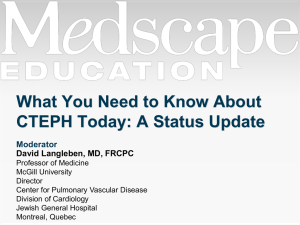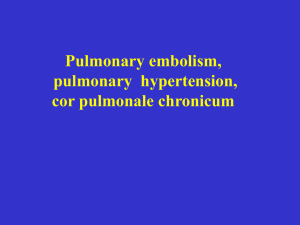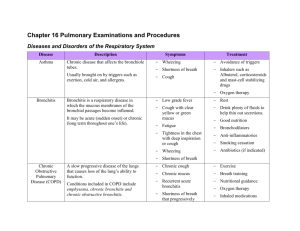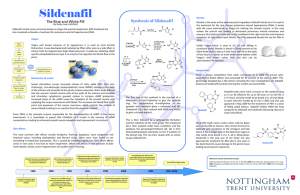Results: During exercise, CTEPH patients had a greater
advertisement
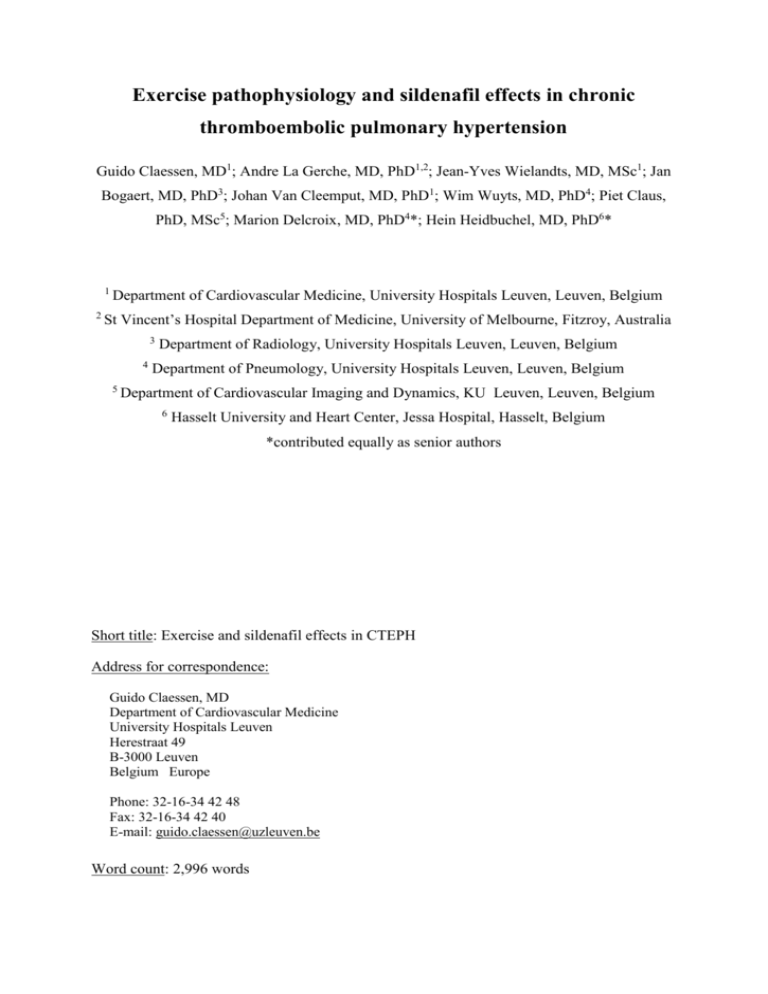
Exercise pathophysiology and sildenafil effects in chronic thromboembolic pulmonary hypertension Guido Claessen, MD1; Andre La Gerche, MD, PhD1,2; Jean-Yves Wielandts, MD, MSc1; Jan Bogaert, MD, PhD3; Johan Van Cleemput, MD, PhD1; Wim Wuyts, MD, PhD4; Piet Claus, PhD, MSc5; Marion Delcroix, MD, PhD4*; Hein Heidbuchel, MD, PhD6* 1 2 Department of Cardiovascular Medicine, University Hospitals Leuven, Leuven, Belgium St Vincent’s Hospital Department of Medicine, University of Melbourne, Fitzroy, Australia 3 4 5 Department of Radiology, University Hospitals Leuven, Leuven, Belgium Department of Pneumology, University Hospitals Leuven, Leuven, Belgium Department of Cardiovascular Imaging and Dynamics, KU Leuven, Leuven, Belgium 6 Hasselt University and Heart Center, Jessa Hospital, Hasselt, Belgium *contributed equally as senior authors Short title: Exercise and sildenafil effects in CTEPH Address for correspondence: Guido Claessen, MD Department of Cardiovascular Medicine University Hospitals Leuven Herestraat 49 B-3000 Leuven Belgium Europe Phone: 32-16-34 42 48 Fax: 32-16-34 42 40 E-mail: guido.claessen@uzleuven.be Word count: 2,996 words Claessen et al. Exercise and sildenafil effects in CTEPH Key words: Chronic thromboembolic pulmonary hypertension – Cardiac magnetic resonance imaging – Right Ventricle – Exercise – Sildenafil – Exercise capacity Page 2 Claessen et al. Exercise and sildenafil effects in CTEPH Page 3 Abstract Objectives: Symptoms in patients with chronic thromboembolic pulmonary hypertension (CTEPH) predominantly occur during exercise, whilst hemodynamic assessment is generally performed at rest. We hypothesized that exercise imaging of right ventricular (RV) function would better explain exercise limitation and the acute effects of pulmonary vasodilator administration than resting measurements. Methods: Fourteen CTEPH patients and 7 healthy control subjects underwent cardiopulmonary testing to determine peak exercise oxygen consumption (VO2peak) and ventilatory equivalent for carbon dioxide (VE/VCO2) at the anaerobic threshold. Subsequently, cardiac magnetic resonance imaging was performed at rest and during supine bicycle exercise with simultaneous invasive measurement of mean pulmonary arterial pressure (mPAP) before and after sildenafil. Results: During exercise, CTEPH patients had a greater increase in the ratio of mPAP relative to cardiac output (CO) than controls [6.7 (5.1–8.7) vs. 0.94 (0.86–1.8) mmHg/L/min; P<0.001]. Stroke volume (SVi) and RV ejection fraction (RVEF) increased during exercise in controls, but not in CTEPH patients (interaction P<0.001). Sildenafil decreased the mPAP/CO slope and increased SVi and RVEF in CTEPH patients (P<0.05) but not in controls. In CTEPH patients, RVEF reserve correlated moderately with VO2peak (r=0.60; P=0.030) and VE/VCO2 (r=-0.67; P=0.012). In contrast, neither VO2peak nor VE/VCO2 correlated with resting RVEF. Conclusions: Exercise measures of RV function explain much of the variance in the exercise capacity of CTEPH patients whilst resting measures do not. Sildenafil increases SVi during exercise in CTEPH patients, but not in healthy subjects. Claessen et al. Exercise and sildenafil effects in CTEPH Page 4 Key questions What is already known about this subject? Some patients with chronic thromboembolic pulmonary hypertension (CTEPH) have worse exercise capacity than others, despite similar resting hemodynamics and right ventricular (RV) function. What does this study add? As compared with measures performed at rest, quantification of RV function performed during exercise provides a substantially better explanation for exercise limitation. The increase in stroke volume following sildenafil administration in CTEPH patients is greater during exercise than at rest. The increase in exercise RV ejection fraction and stroke volume after sildenafil correlates strongly with reductions in pulmonary vascular resistance during exercise. How might this impact on clinical practice? Exercise measures of RV function should be incorporated when evaluating patients with symptoms on exertion. Exercise cardiac magnetic resonance imaging may be used as a non-invasive modality to evaluate the effect of novel pulmonary hypertension therapies on exercise hemodynamics and RV function. Claessen et al. Exercise and sildenafil effects in CTEPH Abbreviations list CO - Cardiac output HR - Heart rate LV - Left ventricle RV - Right ventricle SV - Stroke volume EDV - End-diastolic volume ESV - End-systolic volume EF - Ejection fraction PAP - Pulmonary artery pressure Page 5 Claessen et al. Exercise and sildenafil effects in CTEPH Page 6 Introduction In patients with pulmonary hypertension (PH), right ventricular (RV) function is the most important predictor of outcome [1, 2]. Cardiac magnetic resonance (CMR) imaging studies have emphasized the predictive value of stroke volume index (SVi), RV ejection fraction (RVEF), and indexed RV end-diastolic and end-systolic volumes (EDVi and ESVi, respectively) [1]. These assessments are performed whilst the patient is resting but PH patients typically develop symptoms with physical exertion. Evaluation of RV performance during exercise may better explain why some PH patients have more impaired exercise capacity than others despite similar findings during resting investigations [3]. Despite this rationale for exercise RV imaging, measurement of RV function during exercise is challenging. Recently, real-time CMR imaging has emerged as a promising technique for biventricular volume assessment during exercise with free breathing and without ECG gating [4, 5]. Our group has developed a sequence for real-time CMR imaging during maximal exercise intensity, and has validated its feasibility, accuracy and high reproducibility [5]. It has been demonstrated that patients with PH have an impaired SV response when cardiac imaging is performed immediately after exercise [6, 7]. However, until present, no studies have evaluated RV performance during continuous exercise and free-breathing in patients with chronic thromboembolic pulmonary hypertension (CTEPH). Therefore, the aim of this study was to evaluate biventricular volumes with simultaneous invasive hemodynamic measurements during exercise in CTEPH patients as compared with healthy controls. We sought to evaluate whether exercise RV performance would better explain exercise limitation than resting measures. In addition, we investigated the mechanisms by which the pulmonary vasodilator sildenafil improves exercise capacity in CTEPH patients, and whether non-invasive CMR measures of exercise RV performance are predictive of the improvement in exercise hemodynamics following sildenafil administration. Claessen et al. Exercise and sildenafil effects in CTEPH Page 7 Methods Subjects Fourteen consecutive patients referred to our institution for the assessment and management of CTEPH were invited to participate in this study. All patients were recently diagnosed with CTEPH by pulmonary angiography and right heart catheterization in accordance with contemporary guidelines [8]. None of the patients was on medical therapy with a pulmonary vasodilator. All 14 subjects volunteered to participate in the study. A group of seven healthy control subjects volunteered to participate after responding to local advertisements. All respondents were healthy with no history of cardiovascular disease or risk factors and had a normal ECG and transthoracic echocardiogram. The study protocol conformed to the Declaration of Helsinki and was approved by the local ethics committee. All participants provided informed consent. Study design First, cardiopulmonary exercise testing (CPET) with continuous monitoring of expiratory gases was performed on an upright cycle ergometer (ER900 and Oxycon Alpha, Jaeger, Germany) using a continuous ramp protocol until exhaustion [9]. The anaerobic threshold was identified as the ventilatory equivalent for oxygen (VE/VO2) nadir. Outcome measures included ventilatory equivalent for carbon dioxide (VE/VCO2), VE/VO2 and end-tidal CO2 tension (PETCO2) at the anaerobic threshold. In addition, peak oxygen consumption (VO2peak), maximal power output in Watts (Pmax), capillary to end-tidal CO2 gradient [P(cET)CO2], alveolar-arterial oxygen tension (PA-aO2) difference and the ratio of dead-space to tidal volume (Vd/Vt) ratio were evaluated at maximum exercise. Claessen et al. Exercise and sildenafil effects in CTEPH Page 8 Approximately 24 hours later, all subjects underwent exercise CMR during simultaneous invasive pressure measurement. Prior to exercise, a 7 Fr pulmonary artery catheter was inserted in the internal jugular vein and guided to the proximal right main pulmonary artery under fluoroscopy, whilst a 20 gauge arterial catheter was placed in the radial artery. In the CMR suite, these catheters were attached to CMR-compatible pressure transducers that were connected to a PowerLab recording system (AD Instruments, Oxford, United Kingdom). Mean right atrial (RA) pressure and pulmonary and systemic arterial pressures were continuously recorded during the exercise CMR protocol and analyzed off-line using LabChart v6.1.1 (AD Instruments). All pressure measurements were averaged over 10 consecutive cardiac cycles during unrestricted respiration [10]. Patients underwent exercise CMR at rest and at 25%, 50% and 66% of the maximal power output (Pmax) as determined during the previous CPET. We have previously demonstrated that 66% of the maximal upright exercise power (in Watts) corresponded to the maximal sustainable exercise intensity in a supine position [5]. These workloads will subsequently be referred to as rest, low-, moderate- and peak-intensity exercise. Subjects were then given a single oral dose of sildenafil 50 mg and were allowed to rest for 30-60 minutes. Exercise CMR was repeated at low, moderate and peak-intensity exercise using the same wattages as during the baseline exercise CMR. CMR equipment, image acquisition and analysis Biventricular volumes were measured during supine cycling exercise and free-breathing using a real-time CMR method that we previously described in detail and validated against invasive standards [5]. In brief: subjects performed supine exercise within the CMR bore using a cycle ergometer with adjustable electronic resistance (Lode, Groningen, The Netherlands). Images were acquired with a Philips Achieva 1.5T CMR with a five-element phased-array coil Claessen et al. Exercise and sildenafil effects in CTEPH Page 9 (Philips Medical Systems, Best, The Netherlands). Figure 1 illustrates the technique in a patient with CTEPH. Using an in-house developed software program (RightVol, Leuven, Belgium) LV and RV endocardial contours were manually traced on short-axis images with compensation for respiratory phase and with simultaneous reference to the horizontal long axis plane thus enabling the analyzers (GC and ALG) to confirm the position of the atrio-ventricular plane, as previously described [5]. Volumes were calculated by a summation of disks and indexed for body surface area. SVi was measured as the difference between LV EDVi and LV ESVi. In accordance with previous studies, SVi was determined from LV rather RV volumes because PH patients frequently develop tricuspid regurgitation, particularly during exercise, which may confound the assessment of effective RVSV [11]. Cardiac index (CI) was measured as the product of SVi and heart rate (HR). Ejection fraction (EF) was calculated as (EDV – ESV)/EDV. Total pulmonary resistance (tPVR) was defined as the ratio of mean pulmonary artery pressure (mPAP) to cardiac output (CO, product of stroke volume and HR) and total systemic vascular resistance (tSVR) was calculated as the ratio of mean systemic arterial pressure (mSAP) to CO. Exercise reserve was derived as the difference between rest and peak exercise volume or hemodynamic measures [12]. Blood samples At rest and peak exercise, before and after administration of sildenafil, arterial and central venous blood samples were collected and analyzed for oxygen saturation (SaO2, ScvO2), oxygen tension (PaO2, PcvO2), and carbon dioxide tension (PaCO2, PcvCO2) using an automated blood gas analyzer (ABL 700, Radiometer; Copenhagen, Denmark). Arterialcentral venous differences in oxygen content [C(a-cv)O2] and VO2 at rest and at peak exercise were calculated according to the Fick principle from CMR-derived CO, arterial and central Claessen et al. Exercise and sildenafil effects in CTEPH Page 10 venous oxygen saturations and hemoglobin. Blood samples were further analyzed for creatinine, hemoglobin and N-terminal pro-brain natriuretic peptide (NT-proBNP). Statistical analysis Data were analysed using IBM SPSS statistics 22 software. Descriptive data for continuous variables are presented as meansSEM or as medians (25% and 75% percentile) when appropriate. Categorical data was compared using the Fisher’s exact test. Comparisons between groups for continuous variables were performed using unpaired 2-sample t tests or the Mann-Whitney test, as appropriate. The biventricular volume response from rest to peakintensity exercise in CTEPH patients versus control subjects was compared using a repeated measures analysis of variance (ANOVA) with exercise-intensity and sildenafil as withinsubject effects and group (patients vs. controls) as a between-subject effect. The relationships between CO and mPAP and mSAP, respectively, were determined using linear regression analysis. Analysis of group effects with repeated exercise measures was performed by comparing mean slope coefficients from individual linear regressions. Pearson correlation coefficients were used to evaluate the univariate relationships between resting and exercise measures of biventricular function and CPET parameters. To determine the sample sizes, the following estimates were used: in a recent study using exercise CMR, we demonstrated that healthy subjects had a 12±11 increase in SVi from rest to maximal exercise [5]. According to our hypothesis, we predicted that SVi will not change (0% increase) during exercise in the CTEPH patients. Using these assumptions, a sample size of n = 7 was calculated to provide 80% power in detecting impaired SV augmentation during exercise in the CTEPH group (α = 5%, 1-β = 80%, n = 7). A p-value <0.05 was considered statistically significant. Claessen et al. Exercise and sildenafil effects in CTEPH Page 11 Results The clinical characteristics of the CTEPH patients and control subjects are presented in Table 1 and, as expected, measures of exercise capacity were reduced in CTEPH patients relative to control subjects. The results of the resting and peak exercise hemodynamic and blood gas measurements before and after sildenafil are displayed in Table 2. As expected, patients with CTEPH had higher resting mPAP and tPVR and lower SVi and CI than control subjects. These hemodynamic abnormalities became more prominent during peak exercise. Biventricular function and hemodynamics during exercise in CTEPH patients versus control subjects The pattern of biventricular volume changes during exercise differed between CTEPH patients and control subjects (Figure 2). In control subjects, LVEDVi and RVEDVi did not change from rest to peak-intensity exercise, whilst LVESVi and RVESVi decreased (both P<0.01), and LVEF and RVEF increased (both P<0.01). In contrast, in CTEPH patients, RVEDVi and RVESVi increased with incremental exercise intensity (both P<0.001), whereas LVEDVi and LVESVi decreased (both P<0.05). Therefore, whilst LVEF tended to increase (P=0.094), RVEF remained unchanged during exercise in CTEPH patients (P=0.213). In control subjects, SVi increased during low-intensity exercise (P=0.002) and then remained unchanged during moderate and peak-intensity exercise (Figure 3A). In contrast, in CTEPH patients, SVi did not increase during exercise (P<0.001 for interaction between SVi response to exercise and group). Compared to control subjects, CTEPH patients had a greater increase in HR per watt (1.0±0.1 vs. 0.7±0.1 bpm/W; P=0.020), whereas HR reserve was significantly reduced (55±8 vs. 143±12%; P<0.001), suggesting chronotropic incompetence. Claessen et al. Exercise and sildenafil effects in CTEPH Page 12 As demonstrated in Figure 3B, CTEPH patients had a greater mPAP/CO slope than control subjects [6.7 (5.1–8.7) vs. 0.94 (0.86–1.8) mmHg/L/min; P<0.001]. Furthermore, whilst tPVR tended to decrease during exercise in control subjects (P=0.107), no change in tPVR occurred in CTEPH patients (P=0.967). In contrast, tSVR decreased in both groups during exercise (P<0.01; Table 2). Correlations between RV functional reserve and CPET parameters in CTEPH patients No associations were found between resting RVEF or LVEF and any of the CPET parameters. In contrast, as illustrated in Figure 4, RVEF reserve correlated moderately with VO2peak (r=0.60; P=0.030) and VE/VCO2 (r=-0.69; P=0.009). Similarly, RVEF reserve correlated moderately with VE/VO2 (r=-0.67; P=0.012) and PETCO2 (r=0.76; P=0.002), but not with P(A-a)O2, P(c-ET)CO2 or VD/VT (r=0.063, r=-0.097 and r=-0.279, respectively). Effects of sildenafil on biventricular function and hemodynamics Administration of sildenafil had a different effect on biventricular volumes in control subjects versus CTEPH patients (Figure 2). In control subjects, sildenafil consistently decreased resting and exercise LVEDVi, LVESVi and RVEDVi (mean differences -8±1, -5±2 and -7±2 ml/m2, respectively; all P<0.05), whilst RVESVi remained unchanged. Therefore, whilst LVEF slightly increased, RVEF was not affected by sildenafil (Table 2). In CTEPH patients, LVEDVi decreased during exercise in the baseline setting, but remained constant following sildenafil administration. Changes in RVEDVi during exercise were similar pre- and postsildenafil. More impressively, sildenafil decreased resting and exercise RVESVi (mean difference -6±2 ml/m2; P=0.004), but did not affect LVESVi. As a result, sildenafil increased both resting and exercise LVEF and RVEF in CTEPH patients (Table 2). Figure 3B depicts the reduction of the mPAP/CO slope in CTEPH patients (-3.2±1.2 mmHg/L/min; P=0.020) versus no change in control subjects (P=0.422) following sildenafil Claessen et al. Exercise and sildenafil effects in CTEPH Page 13 administration. Sildenafil decreased resting and exercise tPVR, both in CTEPH patients and control subjects (Table 2). However, the reduction in tPVR was associated with an increase in SVi in the CTEPH group but not in control subjects (interaction group*sildenafil P<0.001; Figure 3). In the CTEPH patients, the reduction in peak exercise tPVR after sildenafil correlated highly with the increase in peak exercise SVi (r=-0.80; P=0.001) and RVEF (r=0.65; P=0.016; Figure 5). Furthermore, the increase in SVi with sildenafil was greater during peak exercise than at rest (5±2 vs. 1±1 ml/m2; P=0.024). Blood gas changes during exercise before and after sildenafil Table 2 depicts the values of the arterial and central venous blood gas analysis at rest and at peak exercise before and after sildenafil. In the CTEPH patients, sildenafil was associated with a reduction in resting PaO2. During exercise, sildenafil was again associated with a reduction in PaO2 but, in addition, was associated with an attenuated reduction in ScvO2 (P=0.016 for interaction) resulting in a reduction in C(a-cv)O2 as compared with the presildenafil setting (supplemental Figure). Discussion In this study, we used simultaneous gold-standard invasive pressure and CMR-derived ventricular volume measurements during incremental exercise to comprehensively describe exercise physiology and limitation in CTEPH patients relative to healthy subjects. Our findings extend previous studies which have typically assessed RV performance immediately after, but not during exercise. Moreover, we found that exercise rather than resting measures of RV function are associated with exercise capacity and ventilatory inefficiency. Furthermore, we provide new insights into the mechanisms by which the pulmonary vasodilator sildenafil improves exercise RV performance and SVi in CTEPH patients, but not in healthy control subjects. Importantly, the increase in peak exercise RV performance after Claessen et al. Exercise and sildenafil effects in CTEPH Page 14 sildenafil correlated with the reduction in peak exercise tPVR, suggesting that exercise CMR may be used as a non-invasive modality to evaluate the effect of novel therapies on exercise hemodynamics and RV function. Importance of RV functional reserve to explain exercise limitation in CTEPH patients Patients with CTEPH typically have an increased ventilatory drive, which is associated with an increase in VE/VCO2 in proportion to the physiologic severity of the disease [13, 14]. Potential mechanisms for this inefficient ventilation include both an increased physiological dead space and an augmentation of the central drive to ventilation, i.e. increased chemosensitivity [15]. In keeping with the latter, we found that both PETCO2 and PaCO2 were significantly lower in the CTEPH cohort compared to healthy controls, suggesting increased chemosensitivity. Interestingly, RV functional reserve during exercise correlated with PETCO2 and PaCO2, but not with parameters suggestive of increased physiological dead space [P(A-a)O2, P(c-ET)CO2 and VD/VT]. Furthermore, we found that exercise measures of RV function were associated with exercise capacity and ventilatory inefficiency, whilst resting measures were not. These observations are consistent with recent data showing that evaluation during exercise using CPET enables identification of CTEPH in patients with suspected PH but normal resting echocardiography [16]. This is clinically relevant as an explanation for why some patients have severe symptoms but relatively modest impairment on resting measures of pulmonary vascular hemodynamics and RV function. Amongst our study patients, impaired RV functional reserve during exercise provided a far better explanation for the disparity between symptoms and resting investigations. Thus, not only pulmonary vascular reserve, but also RV functional reserve should be incorporated when evaluating patients with symptoms on exertion. In clinical practice, this is usually accomplished using exercise Claessen et al. Exercise and sildenafil effects in CTEPH Page 15 echocardiography. RV functional reserve can be measured using parameters such as RV fractional area change [17] or tricuspid annular plane systolic excursion [18], whilst pulmonary vascular reserve can be assessed using Doppler interrogation of the transtricuspid regurgitation jet [17, 18, 19]. However, assessment of RV performance with echocardiography is often challenging due to its complex geometry, its retrosternal position and poor acoustic windows. In these cases, exercise CMR may be an exciting imaging modality to evaluate exercise RV performance. We demonstrate that exercise CMR is feasible even in this population of seriously ill patients and that measurement of RV functional reserve can be obtained during intense exercise in all subjects regardless of body habitus and without the need to perform breath-holds. Acute effects of sildenafil on cardiac hemodynamics Although fixed thrombotic obstructions are the hallmark of CTEPH, several studies have demonstrated acute hemodynamic improvements following administration of sildenafil [20, 21, 22]. It has been postulated that these acute changes with sildenafil in CTEPH are due to its vasodilating effect on the non-obliterated pulmonary vasculature [20, 21]. In this study, we demonstrate that the reduction in RV afterload following sildenafil administration increases the performance of the pressure overloaded RV, which is associated with increased filling of the under-filled LV and an increase in SVi. Contrary to the modest increase which occurred at rest, the magnitude of SVi improvement during peak exercise was far greater with sildenafil and may be considered a clinically relevant change in patients with pulmonary hypertension [23]. It is important to note that the purpose of this study was to evaluate the acute response of sildenafil on exercise hemodynamics, which by itself cannot be used to demonstrate its longterm efficacy. Nevertheless, it is known that acute pulmonary vascular reactivity is a predictor Claessen et al. Exercise and sildenafil effects in CTEPH Page 16 of long-term survival and response to surgery in CTEPH patients undergoing pulmonary endarterectomy. We show that the improvement in peak exercise RVEF and SVi correlates highly with the reduction in exercise tPVR. This may suggest that exercise CMR may be used as a non-invasive modality to evaluate the acute effects of pulmonary vasodilators on exercise hemodynamics. Moreover, the evaluation of RV performance during exercise may represent a promising surrogate measure for future phase 2 clinical studies investigating interventions for pulmonary hypertension. It has been suggested that RV contractile reserve may be more important than resting hemodynamic measurements for determining best therapy and prognosis amongst PH patients [24]. Also, deterioration of RV function after initiation of PHspecific therapy can occur irrespective of changes in PVR and is associated with a poor outcome. In our current study, we describe an exciting novel methodology which may enable future therapies to be tested in this rare condition in an affordable manner. Limitations Firstly, the comprehensive procedures undertaken in this study and the constraints of recruiting healthy subjects for an invasive study protocol limited the sample size. However, the established accuracy of exercise CMR measures enabled us to evaluate meaningful hemodynamic differences within this modest-sized cohort. Secondly, the control subjects had a better exercise capacity than the CTEPH patients. However, determination of workloads was standardized for both groups as a percentage of Pmax obtained during CPET. Moreover, for both groups, changes in LV function served as an ‘internal reference’ for those of the RV. Hence, whilst LV functional changes during exercise mirrored those of the RV in control subjects, a significantly different pattern for both ventricles was observed in CTEPH patients. Finally, because of technical considerations, initially, RA pressure measures were not included in the hemodynamic assessment and, therefore, only available in the last 8 CTEPH patients. Claessen et al. Exercise and sildenafil effects in CTEPH Page 17 Conclusions Exercise measures of RV function explain much of the variance in the exercise capacity of CTEPH patients whilst resting measures do not. During exercise, RV afterload increases disproportionately in CTEPH patients resulting in a marked reduction in RVEF and SV reserve. This effect can be partially reversed with sildenafil. Claessen et al. Exercise and sildenafil effects in CTEPH Page 18 Funding and potential conflicts of interest This study was funded by a grant from the Fund for Scientific Research Flanders (FWO), Belgium. A. La Gerche is funded by a post-doctoral scholarship from the National Health and Medical Research Council of Australia (NHMRC). Disclosures No conflicts to disclose. M Delcroix served as investigator, speaker, consultant, or steering committee member for Actelion, Bayer, Eli Lilly, GlaxoSmithKline, Pfizer and United Therapeutics; and received research grants from Actelion, GlaxoSmithKline and Pfizer. Claessen et al. Exercise and sildenafil effects in CTEPH Page 19 References 1 Vonk-Noordegraaf A, Haddad F, Chin KM, et al. Right heart adaptation to pulmonary arterial hypertension: physiology and pathobiology. J Am Coll Cardiol 2013;62:D22-33. 2 Galie N, Hoeper MM, Humbert M, et al. Guidelines for the diagnosis and treatment of pulmonary hypertension: the Task Force for the Diagnosis and Treatment of Pulmonary Hypertension of the European Society of Cardiology (ESC) and the European Respiratory Society (ERS), endorsed by the International Society of Heart and Lung Transplantation (ISHLT). Eur Heart J 2009;30:2493537. 3 La Gerche A, Claessen G, Burns AT. To assess exertional breathlessness you must exert the breathless. Eur J Heart Fail 2013;15:713-4. 4 Lurz P, Muthurangu V, Schievano S, et al. Feasibility and reproducibility of biventricular volumetric assessment of cardiac function during exercise using real-time radial k-t SENSE magnetic resonance imaging. J Magn Reson Imaging 2009;29:1062-70. 5 La Gerche A, Claessen G, Van de Bruaene A, et al. Cardiac MRI: a new gold standard for ventricular volume quantification during high-intensity exercise. Circ Cardiovasc Imaging 2013;6:329-38. 6 Holverda S, Gan CT, Marcus JT, et al. Impaired stroke volume response to exercise in pulmonary arterial hypertension. J Am Coll Cardiol 2006;47:1732-3. 7 Surie S, van der Plas MN, Marcus JT, et al. Effect of pulmonary endarterectomy for chronic thromboembolic pulmonary hypertension on stroke volume response to exercise. Am J Cardiol 2014;114:136-40. 8 Kim NH, Delcroix M, Jenkins DP, et al. Chronic thromboembolic pulmonary hypertension. J Am Coll Cardiol 2013;62:D92-9. 9 ATS/ACCP Statement on cardiopulmonary exercise testing. Am J Respir Crit Care Med 2003;167:211-77. 10 Lewis GD, Bossone E, Naeije R, et al. Pulmonary vascular hemodynamic response to exercise in cardiopulmonary diseases. Circulation 2013;128:1470-9. Claessen et al. 11 Exercise and sildenafil effects in CTEPH Page 20 Lurz P, Muthurangu V, Schuler PK, et al. Impact of reduction in right ventricular pressure and/or volume overload by percutaneous pulmonary valve implantation on biventricular response to exercise: an exercise stress real-time CMR study. Eur Heart J 2012;33:2434-41. 12 Haddad F, Vrtovec B, Ashley EA, et al. The concept of ventricular reserve in heart failure and pulmonary hypertension: an old metric that brings us one step closer in our quest for prediction. Curr Opin Cardiol 2011;26:123-31. 13 Yasunobu Y, Oudiz RJ, Sun XG, et al. End-tidal PCO2 abnormality and exercise limitation in patients with primary pulmonary hypertension. Chest 2005;127:1637-46. 14 D'Alonzo GE, Gianotti LA, Pohil RL, et al. Comparison of progressive exercise performance of normal subjects and patients with primary pulmonary hypertension. Chest 1987;92:57-62. 15 Naeije R, van de Borne P. Clinical relevance of autonomic nervous system disturbances in pulmonary arterial hypertension. Eur Respir J 2009;34:792-4. 16 Held M, Grun M, Holl R, et al. Cardiopulmonary exercise testing to detect chronic thromboembolic pulmonary hypertension in patients with normal echocardiography. Respiration 2014;87:379-87. 17 La Gerche A, Burns AT, D'Hooge J, et al. Exercise strain rate imaging demonstrates normal right ventricular contractile reserve and clarifies ambiguous resting measures in endurance athletes. J Am Soc Echocardiogr 2012;25:253-62 e1. 18 Kusunose K, Popovic ZB, Motoki H, et al. Prognostic significance of exercise-induced right ventricular dysfunction in asymptomatic degenerative mitral regurgitation. Circ Cardiovasc Imaging 2013;6:167-76. 19 La Gerche A, MacIsaac AI, Burns AT, et al. Pulmonary transit of agitated contrast is associated with enhanced pulmonary vascular reserve and right ventricular function during exercise. J Appl Physiol (1985) 2010;109:1307-17. 20 Suntharalingam J, Hughes RJ, Goldsmith K, et al. Acute haemodynamic responses to inhaled nitric oxide and intravenous sildenafil in distal chronic thromboembolic pulmonary hypertension (CTEPH). Vascul Pharmacol 2007;46:449-55. Claessen et al. 21 Exercise and sildenafil effects in CTEPH Page 21 Ulrich S, Fischler M, Speich R, et al. Chronic thromboembolic and pulmonary arterial hypertension share acute vasoreactivity properties. Chest 2006;130:841-6. 22 Voswinckel R, Reichenberger F, Enke B, et al. Acute effects of the combination of sildenafil and inhaled treprostinil on haemodynamics and gas exchange in pulmonary hypertension. Pulm Pharmacol Ther 2008;21:824-32. 23 van Wolferen SA, van de Veerdonk MC, Mauritz GJ, et al. Clinically significant change in stroke volume in pulmonary hypertension. Chest 2011;139:1003-9. 24 Grunig E, Tiede H, Enyimayew EO, et al. Assessment and prognostic relevance of right ventricular contractile reserve in patients with severe pulmonary hypertension. Circulation 2013;128:2005-15. Claessen et al. Exercise and sildenafil effects in CTEPH Page 22 Figure legends Figure 1. Illustration of biventricular volume changes during exercise in a CTEPH patient. The upper panels show a representative mid-ventricular slice at rest and during peak-intensity exercise. The lower panels show the three-dimensional volume stack generated by the software after manual delineation of left and right ventricular (LV and RV) endocardial borders at end-diastole (upper panels) and end-systole (bottom). During exercise, RV volumes become larger whereas RV ejection remains unaltered. As a result, the LV becomes progressively underfilled and stroke volume augmentation is impaired. EDV, end-diastolic volume; ESV, end-systolic volume. Figure 2. Comparison of biventricular volume changes during incremental exercise in CTEPH patients and healthy control subjects before and after sildenafil. Workloads are presented as a percentage of maximum power output (Pmax) determined during previous cardiopulmonary exercise testing. P-values are shown for the interaction between group (patients vs. controls) and exercise-intensity using repeated measures analysis of variance (ANOVA). † denotes significant interaction (P<0.05) between volume response to exercise pre- vs. post sildenafil. Data are presented as means and SEM at each time point. EDVi, indexed end-diastolic volume; ESVi, indexed end-systolic volume. Figure 3. Stroke volume and pulmonary vascular reserve in CTEPH patients versus healthy control subjects before and after sildenafil. (A) Stroke volume (SVi) response from rest to peak-intensity exercise in CTEPH patients versus control subjects before (solid lines) and after sildenafil (dashed lines). Asterisks denote significant differences between pre- and post-sildenafil within each cohort by paired sample t test. Workloads are presented as a percentage of maximum power output (Pmax) determined Claessen et al. Exercise and sildenafil effects in CTEPH Page 23 during previous cardiopulmonary exercise testing. (B) Linear mean pulmonary artery pressure (mPAP)-flow relationships based on averages of serial measurements of mPAP and cardiac output (CO) during incremental exercise before (solid lines) and after (dashed lines) sildenafil. Error bars denote SEM. P-values are given for differences in mPAP/CO slope between pre-and post-sildenafil using paired sample t test. Figure 4. Correlations between right ventricular functional reserve and measures of exercise capacity and ventilatory efficiency. The exercise-induced change in right ventricular ejection fraction (RVEF reserve) correlated with (A) peak oxygen consumption (VO2peak) and with (B) end-tidal carbon dioxide tension (PETCO2), (C) ventilatory equivalent of carbon dioxide (VE/VCO2) and (D) ventilatory equivalent of oxygen (VE/VO2) at anaerobic threshold (AT). Figure 5. Correlations between peak exercise RV performance and pulmonary vascular resistance following sildenafil. The change in peak exercise total pulmonary vascular resistance (∆tPVR) after sildenafil correlated highly with changes in (A) peak exercise stroke volume (∆SVi) and (B) peak exercise right ventricular ejection fraction (∆RVEF). Claessen et al. Exercise and sildenafil effects in CTEPH Page 24 Table 1. Clinical characteristics Age, yrs Male sex, % Weight, kg BMI, kg/m2 BSA, m2 NYHA functional class, n I II III IV NTproBNP, ng/l Hb, g/dl Creatinine , mg/dl 6MWD, m CPET parameters Peak power output, W Peak heart rate, bpm Healthy controls (n=7) 51±2 71 78±7 25.8±2.1 1.92±0.08 CTEPH (n=14) 61±4 71 84±5 28.2±1.5 1.96±0.07 P-value 39 (37 – 56) 13.4±0.3 0.78±0.03 - 1 4 9 0 537 (239 – 1428) 15.0±0.3 0.85±0.05 359±42 0.001 0.005 0.265 - 221±27 170±7 78±8 126±6 0.001 <0.001 0.065 1.000 0.535 0.360 0.745 VO2peak, ml/kg/min 34.4±4.3 13.2±1.1 0.002 Vd/Vt, % 26±1 45±2 <0.001 PA-aO2, mmHg 29±6 62±4 <0.001 P(c-ET)CO2, mmHg 0.33±1.2 7.4±0.8 <0.001 VE/VO2 at AT 24.2±0.5 42.2±1.9 <0.001 VE/VCO2 at AT 24.9±0.5 48.3±2.2 <0.001 PETCO2 at AT, mmHg 42.8±1.2 23.3±1.1 <0.001 Data presented as mean±SE or median (25% and 75% percentile); P-values from Fisher’s exact test, unpaired 2-sample t tests or Mann-Whitney test were appropriate CTEPH, chronic thromboembolic pulmonary hypertension; BMI, body mass index; BSA, body surface area; NYHA, New York Heart Association; NTproBNP, N-terminal pro-brain natriuretic peptide; Hb, hemoglobin; 6MWD, 6-minute walking distance; CPET, cardiopulmonary exercise testing; VO2peak, peak oxygen consumption; Vd/VT, ratio of deadspace to tidal volume; PA-aO2, alveolar-arterial oxygen tension difference; P(c-ET)CO2, capillary to end-tidal carbon dioxide gradient; VE/VO2, ventilatory equivalent of oxygen; VE/VCO2, ventilatory equivalent of carbon dioxide; PETCO2, end-tidal carbon dioxide tension Claessen et al. Exercise and sildenafil effects in CTEPH Page 25 Table 2. Changes in gas exchange parameters, biventricular function and hemodynamics from rest to peak exercise before and after sildenafil Controls (n = 7) PrePostP sildenafil sildenafil value Heart rate, bpm Rest Peak ex LVEF, % Rest Peak ex RVEF, % Rest Peak ex SVi, ml/m2 Rest Peak ex CI, l/min.m2 Rest Peak ex mSAP, mmHg Rest Peak ex mPAP, mmHg Rest Peak ex RA pressure, Rest mmHg Peak ex tPVR Rest dyne/s/cm5 Peak ex tSVR, Rest dyne/s/cm5 Peak ex tPVR/tSVR Rest ratio Peak ex PaO2, mmHg Rest Peak ex PaCO2, mmHg Rest Peak ex ScvO2,% Rest Peak ex C(a-cv)O2, Rest ml O2/100 mL Peak ex 61±3 147±4 † 60.7±2.1 69.6±1.6 † 59.1±2.3 73.2±1.9 † 53±5 59±6 3.1±0.3 8.7±1.1 † 101±5 125±3 † 11±1 24±3 † 154±23 126±22 1483±217 661±86 † 0.11±0.01 0.20±0.02 † 102±7 90±6 36±2 37±1 73±2 43±6 † 4.8±0.4 10.8±1.0 † 78±4 153±7 † 65.6±2.6 73.0±1.7 † 62.5±3.3 75.3±3.2 † 50±5 57±6 3.7±0.2 8.8±1.2 † 91±5 118±4 † 8±1 19±1 † 97±11 95±11 1072±108 639±114 † 0.09±0.01 0.16±0.01 † 85±6 95±7 37±1 33±2 † 74±1 41±5 † 4.4±0.2 11.3±0.9 † 0.002 0.186 0.072 0.044 0.268 0.436 0.370 0.462 0.019 0.692 0.058 0.062 0.012 0.026 0.012 0.105 0.012 0.641 0.094 0.037 0.078 0.294 0.541 0.053 0.669 0.201 0.169 0.303 CTEPH (n = 14) PrePostP value sildenafil sildenafil 79±3 * 82±3 122±5 †* 118±5 †* 61.0±2.5 63.5±2.2 64.1±3.6 67.4±3.2 † 36.2±1.8 * 40.1±1.9 * 34.8±2.2 * 40.0±3.0 * 35±2 * 37±2 * 34±3 * 39±3 * 2.7±0.2 2.9±0.2 * 4.1±0.3 †* 4.5±0.2 †* 94±4 83±3 117±6 † 105±5 † 45±3 * 38±2 * 64±3.0 †* 54±3.0 †* 8±2 6±2 19±3 † 14±4 † 727±53 * 553±41 * 688±63 * 527±53 * 1565±154 1227±104 1271±136 †* 1031±109 †* 0.48±0.03 * 0.47±0.03 * 0.59±0.04 †* 0.53±0.03 †* 71±6 * 56±3 * 65±6 * 56±3 * 33±1 33±1 * 29±1 †* 31±1 † 65±2 * 62±2 * 38±3 † 41±3 † 6.3±0.4 * 6.0±0.3 * 11.3±0.6 † 10.2±0.6 † 0.152 0.038 0.004 0.006 <0.001 0.002 0.036 0.009 0.006 0.021 0.001 0.001 <0.001 <0.001 0.044 0.017 <0.001 <0.001 <0.001 0.001 0.130 0.019 0.001 0.037 0.529 0.020 0.057 0.083 0.434 0.003 P-values from repeated measures ANOVA for difference between pre-and post-sildenafil and for rest vs. peak exercise; † P<0.05 for difference vs. rest; * P<0.05 for difference vs. healthy control subjects by unpaired 2-sample t test CTEPH, chronic thromboembolic pulmonary hypertension; LVEF, left ventricular ejection fraction; RVEF, right ventricular ejection fraction; SVi, indexed stroke volume; CI, cardiac index; mSAP, mean systemic arterial pressure; mPAP, mean pulmonary arterial pressure; RA, right atrial pressure; tPVR, total pulmonary vascular resistance; tSVR, total systemic vascular resistance; PaO2, arterial oxygen tension; PaCO2, arterial carbon dioxide tension; ScvO2, central venous oxygen tension; C(a-cv)O2, arterial-central venous oxygen content difference Claessen et al. Exercise and sildenafil effects in CTEPH Page 26 The Corresponding Author has the right to grant on behalf of all authors and does grant on behalf of all authors, an exclusive licence (or non exclusive for government employees) on a worldwide basis to the BMJ Publishing Group Ltd and its Licensees to permit this article (if accepted) to be published in HEART editions and any other BMJPGL products to exploit all subsidiary rights.
